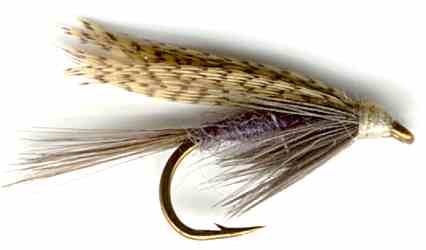The Dark Hendrickson Wet Fly
The Dark Hendrickson fly pattern is a good general mayfly dun imitation patterns for drowned and crippled mayflies that have dark bodies. Choose the hook size and color to match your local hatch.

WET FLY PATTERNS. Hook size 12 14 - $US each
Back in 1915 Albert Everett Hendrickson of Scarsdale, NY, USA wrote to Roy Steenrod, about tying a fly to match the dark North American up-winged dun mayfly Ephemerella subvaria. Roy lived in Liberty, NY and fished the Beaver Kill, Esopus, Nerversink and Willowemoc rivers. Albert uwas invited to accompany Roy on some fishing trips. One day in 1916 whilst fishing on the Beaver Kill river below the junction pool at Roscoe, a hatch of flies came on. They had never seen the fish rise so freely for any fly as they did for this hatch. Roy caught one of the insects and put it in his fly box and tied a fly to match.
They tried it out after lunch. they took fish after fish with this new fly pattern day after day. Two days after the fly was first tied the matter was brought up as to what to call this killer pattern. Roy named it after his new fishing friend and it has been known as the Hendrickson ever since. (Please note that there is a dispute over who originally tied them as some credit Art Flick though I favor the above story) These flies are used all over the USA but is not well known outside North America. This is a shame as I have found them both to be a very productive fly in British and European waters for imitating iron blue duns.
The Hendrickson is a great attracter pattern. It can be about as deadly as the all year around Adams Dry Fly. An attracter pattern is designed to stimulate a predatory fish's aggression. They do not try to imitate the fish's food. They just provoke a predatory attack response. Although these flies were designed to imitate a certain insect they can be used in areas and at times of the year when that fly is not present. Try a Hendrickson when all logic says it shouldn't work. Use it as an attractor, something different that will catch a trout's hungry eye. It is a fly that has saved the day for me many a time when the fish were not rising for anything I cast to them. This is a pattern that every fly box should not be without.

